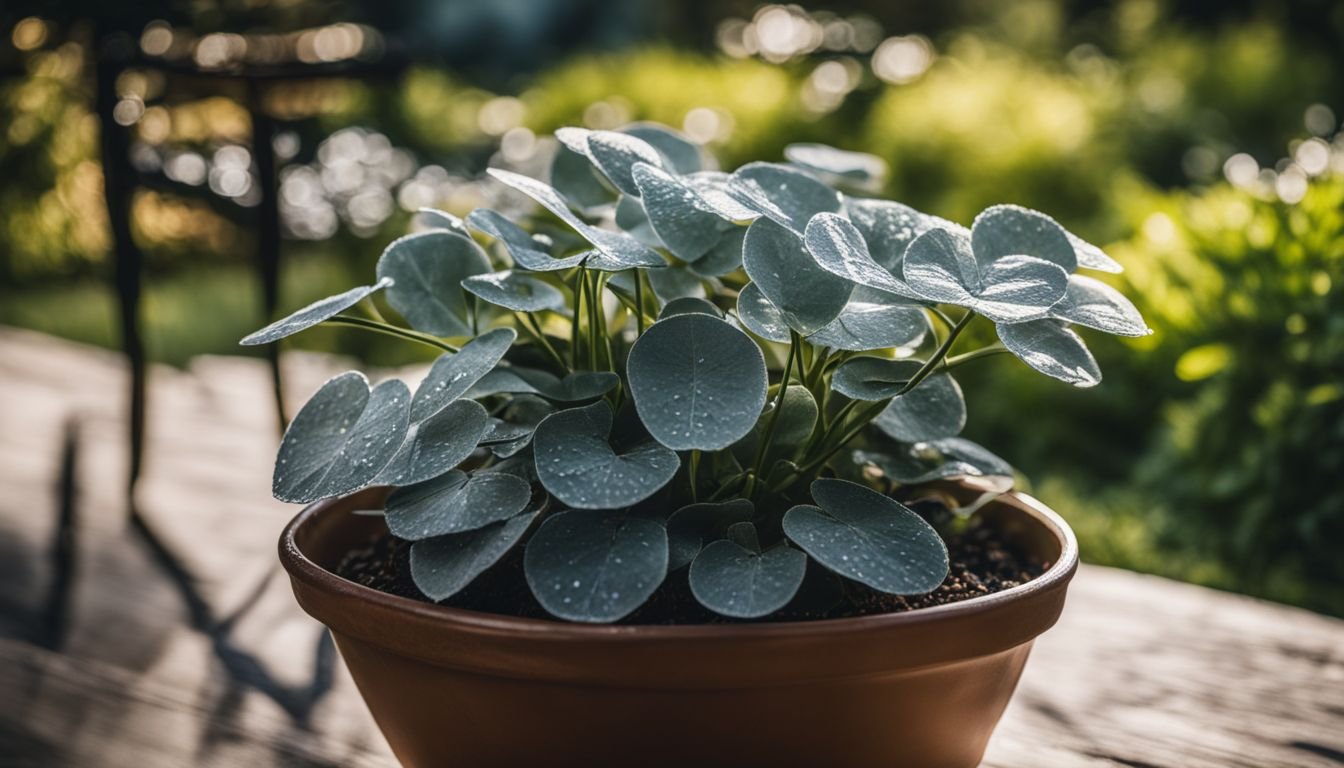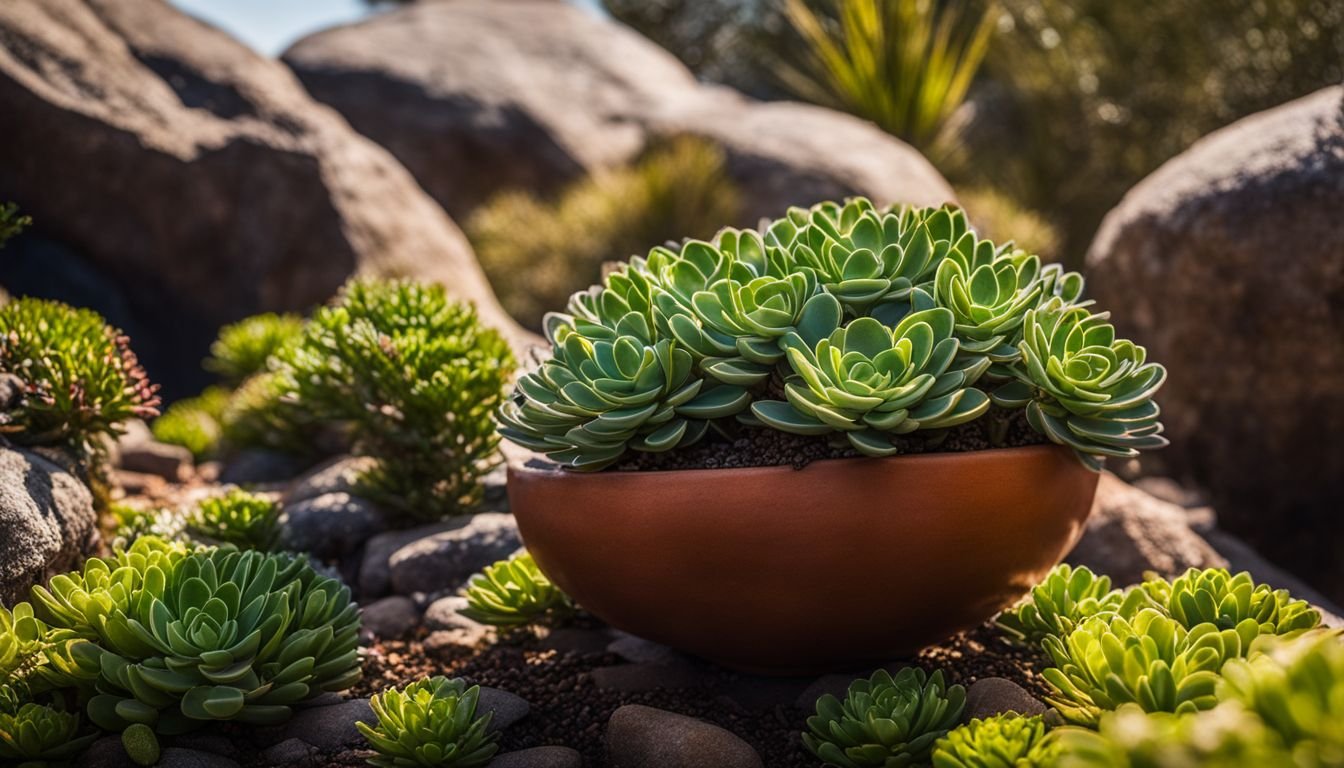Are you on the hunt for the ultimate plant to spruce up your Aussie garden? We all crave a lush outdoor space that’s both a sight for sore eyes and not too much of a hassle to care for.
Trust me, we’ve roamed far and wide in search of that perfect addition to our backyards or as a cheeky companion on the windowsill. And you know what? We’ve stumbled across something pretty special: Crassula arborescens.
This stunning succulent, affectionately known as the Silver Jade Plant, isn’t just easy on the eyes but is also surprisingly low-maintenance.
Our team has gone all out to compile everything there is to know about raising Crassula arborescens right here on Aussie soil. From its rugged beginnings in South Africa’s rocky terrain to thriving in your own backyard oasis, this guide leaves no stone unturned.
You’ll discover how to whip up the ideal environment for it, dodge common health hiccups, and even how to propagate new plants from leaf cuttings yourself. Keen for a greener thumb? Read on!
Key Takeaways
- Crassula arborescens, or the Silver Jade Plant, is a low-maintenance and drought-tolerant succulent that fits well in Australian gardens due to its preference for warm, dry climates similar to its native South Africa.
- Proper care includes using well – draining potting mix, ensuring ample sunlight with some partial shade, and watering sparingly to prevent root rot while keeping an eye out for pests like mealybugs and aphids.
- This plant can grow up to 4 feet tall and produces star – shaped pink or white flowers in spring or summer, adding ornamental value both outdoors in rock gardens or as an indoor houseplant.
- Propagation of Crassula arborescens is straightforward through cuttings or seeds. For quicker growth, planting a healthy cutting into the right soil mix can lead to successful propagation.
Understanding Crassula arborescens

Crassula arborescens, also known as Silver Dollar Plant or Chinese Jade, stands out in any garden. This succulent thrives under direct sunlight and blooms white to pink flowers that add a dash of colour.
Description and Characteristics
We love sharing our knowledge about the Crassula arborescens, known to many as Chinese Jade or Silver Dollar Plant. This lovely succulent shows off with rounded blue-gray leaves that boast maroon edges and tiny maroon spots on top.
It’s a stunning view in any garden or as a houseplant on your desk. Growing up to 4 feet tall, it brings life into spaces with its star-shaped pink or white corollas appearing in spring or summer.
This plant thrives best in potting soil made just right for cacti and similar fleshy plants, showing how versatile it is in different environments. Given its roots lie deep within South Africa, it’s no surprise this beauty is tough against drought and can stand up to deer, dry ground conditions, and rocky terrain without much fuss.
Despite being nearly free from diseases, we still keep an eye out for those sneaky mealybugs and aphids that might try their luck.
“A garden requires patient labor and attention.”
Let’s move on to finding out what kind of environment suits Crassula arborescens the best.
The Ideal Environment for Crassula arborescens

Crassula arborescens thrives in warm, dry spots that mimic its native South African habitats like the Western Cape and Little Karoo. These succulents love the sun and well-draining ground, making them perfect for Australian rock gardens or as a charming house addition in pots.
To give these ornamental plants the best shot at flowering and showing off their simple yet beautiful blooms, pick a spot where they can soak up plenty of sunshine without sitting in wet soil, which could lead to root issues.
Keep reading to learn how to create an ideal home for your Crassula arborescens!
Climate and Habitat Requirements
Crassula arborescens loves the warm, dry climate much like its native South Africa, making it a perfect match for many Australian gardens. This succulent plant thrives best in full sun to partial shade.
It means we should place them where they can soak up plenty of sunlight, yet still enjoy some relief from the harshest midday rays. These conditions mimic their original home in regions such as the Little Karoo and Renosterveld areas of the Western Cape.
In our gardens, crassula arborescens adapts well to various types of soil but prefers those that drain quickly to avoid root rot, a common issue when moisture lingers too long around its roots.
Planting them in raised beds or rock gardens not only meets their drainage needs but also showcases their ornamental beauty effectively. For gardeners living in parts of Australia that match USDA Plant Hardiness Zones 9a to 11b, growing crassula arborescens outdoors throughout the year is an achievable goal.
How to Grow Crassula arborescens
Growing Crassula arborescens starts with choosing the right soil. Go for a well-draining potting mix, which mimics their natural habitat in South Africa. This selection ensures they get enough air around their roots while keeping them from sitting in water too long.
Next, consider propagation methods like using cuttings or seeds. For quicker results, snip off a healthy piece and plant it directly into your chosen soil mixture. If you opt for seeds, scatter them thinly over the surface and lightly cover with more soil mix.
With patience and care, these tiny beginnings will grow into sturdy plants that can withstand droughts just like those found in their native fynbos regions.
Planting and Watering Techniques
Crassula arborescens, native to South Africa, thrives in our Australian gardens with the right care. This plant’s success starts with proper planting and accurate watering methods.
- Choose potting soil made for cacti and succulents. This special mix helps prevent water from staying around the roots too long, which can cause rot.
- Find a bright spot where your plant can soak up full sun to light shade. Crassula arborescens loves sunlight but also does well in partial shade.
- Use containers with holes in the bottom for drainage. Good drainage is crucial to keep your plant healthy and avoid waterlogging.
- Water your crassula sparingly. These plants are drought tolerant and prefer their soil to dry out between waterings.
- Check the soil moisture before watering again. If the top inch feels dry, it’s time to give your plant a drink.
- Avoid getting leaves wet when you water. Wet leaves can lead to fungal diseases that harm the plant.
- In hot months, watering might be needed more often but cut back during cooler seasons when growth slows down.
Following these simple steps will ensure your Crassula arborescens grows strong and resilient, adding beauty and interest to your garden or home as a lovely houseplant.
Caring for Crassula arborescens
Keeping Crassula arborescens healthy requires a keen eye on its needs. We must watch for signs of sickness or insect issues that might harm our plant.
Dealing with Potential Diseases and Pests
We know our Crassula arborescens needs love and attention to stay healthy. Mealybugs, vine weevil, aphids, and fungal diseases can be real trouble for these plants. Let’s keep them at bay with these steps:
- Check your plant regularly for mealybugs. These little pests look like tiny cotton balls. If you spot any, gently cleanse the affected area with a cotton swab dipped in rubbing alcohol.
- Keep an eye out for signs of fungal diseases. These usually show up as brown or black spots on the leaves. Cut off the affected leaves straight away and make sure your plant gets plenty of air circulation.
- Vine weevil larvae feed on roots and can cause serious damage. Inspect the soil of your crassulaceae when repotting and remove any grubs you find.
- Aphids are small but mighty pests that suck sap from your plant’s leaves, making them weak. Blast them off with a gentle stream of water from a hose or apply an insecticidal soap solution.
- Make sure your Crassula arborescens doesn’t sit in soggy soil – it encourages root rot and attracts pests! Well-draining soil is key to keeping it happy and healthy.
- A simple way to stop pests is by introducing beneficial insects like ladybugs into your garden . They love snacking on aphids!
Now let’s talk about how to propagate Crassula arborescens from cuttings…
Conclusion
Growing Crassula arborescens, the beautiful Silver Jade Plant, brings a touch of South Africa to Australian gardens. This succulent loves sun and doesn’t ask for much water, making it perfect for our climate.
Keep an eye out for pests like mealy bugs and signs of fungal diseases to keep your plant happy and healthy. Propagating this plant is as simple as planting a leaf cutting. With its stunning pink or white flowers in spring and summer, Crassula arborescens adds beauty to any outdoor space or indoor collection.
So why not give it a try? It’s a great addition to any garden looking for drought-tolerant charm.
FAQs
1. What is Crassula arborescens?
Crassula arborescens is a type of house plant from the Aizoaceae family, known for its simple dry fruits and seed leaves.
2. How do you grow Crassula arborescens in Australia?
You can grow Crassula arborescens by sowing seeds or using cuttings. Make sure they get enough sunlight but protect them from the harshest midday rays.
3. Can I use any special payment methods to buy Crassula arborescens online?
Yes, when buying this plant or its seeds online, most nurseries accept various payment methods including Visa, American Express, PayPal, and even Apple Pay.
4. What kind of care does Crassula arborescens need?
This plant thrives with minimal water – think of it like a cacti from the Cactaceae family! Ensure well-draining soil and only water when the soil feels dry to the touch.
5. Is Crassula arborescens good for attracting wildlife to my garden?
Absolutely! The nectar from its flowers attracts pollinators to your garden, helping your other plants thrive as well.
